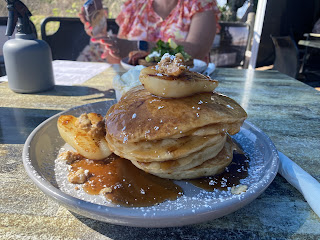Port Hedland! [The Australian Project]
You'll notice that this blog is a bit more informative than entertaining, that's because this blog is for The Australian Project - a task my school is doing - where you can write about a person, a place, or anything else as long as it's Australian. This (my) text is about Port Hedland! If this is you're first blog here, don't take this as a first impression, normally my blogs are a lot different than this.
Port Hedland
Port Hedland is a very important town to Western Australia; allowing mining companies to export iron ore, manganese, gold, salt and other resources around the world.
- Ship being loaded with iron ore -
Port Hedland is known as "Marapikurrinya" by the Kariyarra people, and each syllable means something;
marra - hand,
pikurri - pointing straight
nya - a place name marker
This refers to the five tidal creeks that run into the port, each one resembling a finger, of course.
This refers to the five tidal creeks that run into the port, each one resembling a finger, of course.
- The Five Tidal Creeks -
Captain Peter Hedland was one of the first Europeans to explore this coastline. Peter arrived in the area in April, 1863, on his boat, Mystery. He decided to name the area Mangrove Harbour. He then reported that this would be a great landing site, as it was well protected and has fresh water.
In 1866, a port was required in the Pilbara region to service the needs of local farmers in East Pilbara, so the government of Roebourne sent Charles Wedge to examine the reported Mangrove Harbour as an alternate port, since although Roebourne had been chosen as a settlement, it's distance from the shore was a large disadvantage. Unfortunately, Charles encountered difficulties in his efforts, as he was hampered by heavy rain and with the tidal creeks around Mangrove Harbour, he was unable to reach the proposed port site to survey its suitability.
1891. The area was now re-explored by Tom Traine, John Wedge and Syd Hedley. This trio reached their destination and described Mangrove Harbour as, "Pretty, as well as safe,". The port also has a natural dip underwater, allowing ships to wait outside the harbour, even when the tide goes down, this is another fact that made the spot perfect.
In 1898, the construction of a jetty was completed, allowing the arrival of food and settlers into Mangrove Harbour. This also helped significantly with the construction of the town, as there was no reliable timber or other building material available, so everything had to be shipped in. As of today, the town is known as Port Hedland - representing the first Captain to explore the area.
In 1908, gold was found near Marble Bar. This increased the activity in the area, so more docks had to be built. In 1952, manganese was found in Woodie Woodie, and this provided the port with a yet another boost of activity.
1966. The railway from Goldsworthy to the port - which despite the name, is an iron ore mining town - was complete, and iron ore began to be shipped from the port. 'Leslie Salt' sent construction equipment to some unused land with intension to develop a salt farm, and within two years, it was up and running, with salt also being exported.
With iron ore, manganese, salt & gold all being exported, the port had to grow, as the were a lot more ships coming in now.
These days the largest exporters at Port Hedland are BHP, Fortescue Metals, and Roy Hill. BHP has five mines scattered across the Pilbara Region, mainly producing iron ore. Fortescue Metals (also known as FMG,) owns three mines, producing iron ore, gold, and copper. Roy Hill isn't a company - instead 'Roy Hill' is the mine, as there's only one; though it provides lots of iron ore.
Iron ore, manganese, and other materials are transported to the port by railway. These can be up to 7 km long. Huh? Were you expecting something more grand? Oh, sorry... you may have misunderstood... the trains can be up to 7 km long, the track is 208 km.
Today, Port Hedland exports MASSIVE amounts of material. For example, in April, 2022, the port exported 59.1 million tonnes of iron ore over the month. Other resources have similar numbers, though iron tends to have the highest demand, and so is exported the most.
- Port Hedland -
Now days, Port Hedland is the largest bulk export port in the world and also the third biggest port overall!
Bibliography
History - Kiddle.co, PortHedlandNOW.
Port Facts - We learned quite a bit on different tours, so I used
a lot of that information here, checking online
that I heard correctly, of course.
Images - Google, our own photos.















Comments
Post a Comment
This is the comments section! If this is your first time, you should check out the "How To Comment" blog first.